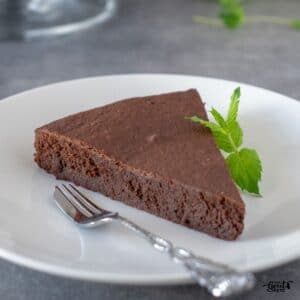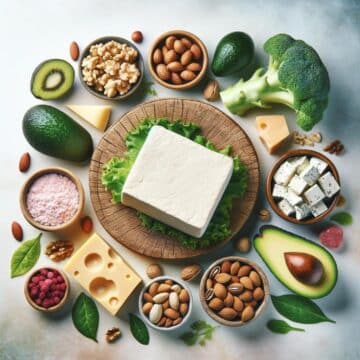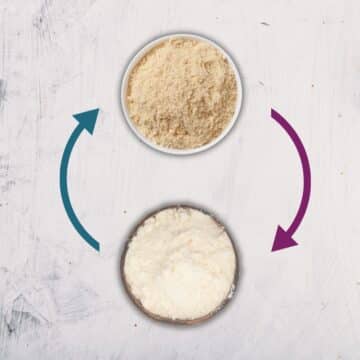In your pre-keto days, you’ve probably used baking chocolate more than once in your desserts. After all, that’s what this type of chocolate is for. That’s why you’ll find it in the baking aisle.
But now that you’re trying to keep your carb intake low, you’re wondering whether baking chocolate is compatible with this lifestyle.
The answer is not a simple yes or no because there are so many types of baking chocolate. The sheer number of options can leave your head spinning. For example, do you choose bitter or sweet? What about baking chocolate labeled “sugar-free?” And what about white chocolate?
To get you through this conundrum, here is everything you need to know about baking chocolate on the keto diet, including what it is, what types there are, and substitutes.
The Unsweetened Truth About Baking Chocolate
Baking chocolate is a type of dark chocolate produced for — you guessed it — baking. Also called cooking chocolate or bitter chocolate, baking chocolate is composed of at least 35% cocoa solids and cocoa butter [1]. The remainder is mainly sugar.
It contains almost 100% cocoa solids with a small amount of cocoa butter and no added sugar in its purest form. But there are many other forms of baking chocolate as well.
In case you’re not familiar:
Cocoa solids: The dry components of cocoa beans are left after removing the fat. Cocoa powder is made by drying and grinding cocoa solids.
Cocoa butter: Pure fat extracted from the cocoa bean. It is pale yellow in color and accounts for half of the weight of cocoa beans.
Baking chocolate is typically found in the baking aisle in most supermarkets. Popular brands of baking chocolate include Hershey’s, Baker’s Chocolate, and Lindt, all of which you can find at any store.
Making desserts with baking chocolate may seem like a no-brainer. However, there’s a reason chocolate connoisseurs and pastry chefs rarely use it: it’s too often low-quality compared to dark and other varieties.
Some brands of baking chocolate, for example, use low-quality cocoa and ingredients that should have no place in chocolate, like palm oil. These things impact its flavor and mouthfeel.
To avoid this problem, choose renowned brands of dark chocolate or carefully read the label before buying baking chocolate.
From Dark to White: A Choco-Lover's Guide to Baking Chocolate Types
Different recipes require different types of chocolate. Keto baking becomes a breeze once you become familiar with the different varieties. Plus, knowing your chocolate will help you avoid baking mishaps and unpleasant surprises. With that said, the main types of baking chocolate are [2]:
Unsweetened
Unsweetened baking chocolate, also known as bitter chocolate, is just pure chocolate. It consists of cocoa solids with a small amount of cocoa butter and no sugar; in other words, 100% cocoa solids. This is a great option if you need to create a deeper flavor. And, of course, it has fewer carbs compared to sweetened varieties.
Bittersweet and semi-sweet
Bittersweet and semi-sweet bars contain some amount of sugar as well as emulsifiers and vanilla. These are slightly sweeter than pure chocolate, with a cacao percentage ranging from 35% to 85%. Low-carb varieties are available and contain non-nutritive sweeteners.
Sweet
Sweet baking chocolate, also known as “German’s sweet chocolate,” after its inventor Samuel German is dark baking chocolate with a high sugar content popularly used to make German chocolate cake.
Couverture chocolate
Couverture is high-quality chocolate with a higher percentage of cocoa butter, usually around 30%. Its cocoa solids are ground to a super fine consistency. This type is used by professional pastry chefs and used in gourmet desserts. The addition of cocoa butter gives this chocolate a glossy sheen, firmness, and a buttery flavor.
Compound chocolate
This is more of a confectionary than “true” chocolate. It is made with hydrogenated fats in place of cocoa butter to reduce costs. So it’s essentially a cheaper alternative to real chocolate. It is even illegal for manufacturers to label such products as chocolate in some countries.
White baking chocolate
White chocolate comprises at least 20% cocoa butter, milk solids, sugar, and emulsifiers. It does not have any cocoa solids, hence the pale color, unlike regular chocolate. It’s used to make white truffles, blondies, cheesecake and is often combined with dark chocolate in many desserts.

Bars, blocks, chips ...
Baking chocolate is also sold as bars, blocks, wafers, and chips. Bars, blocks, and wafers are typically better for baking since they contain higher quality ingredients, while chips contain stabilizers and less cocoa butter to prevent them from melting. The chips are usually used in cookies and muffins as add-ins.
Keto Dieters Rejoice: Baking Chocolate Can Be Your Sweet (Low-Carb) Escape
Baking chocolate can be keto. Unsweetened baking chocolate has around 1-2g net carbs per 14g square or approximately 12g net carbs in one 100g bar [3]. And while that may seem like a lot, these carbs become diluted in keto baked goods once you mix them with the other ingredients, like milk, butter, and eggs.
In case you’re wondering where these carbs are coming from since unsweetened chocolate does not contain added sugar: from the cocoa solids. Cocoa solids are 20% digestible carbohydrates [4]. The rest is fiber and protein.
When buying baking chocolate for your keto desserts, it’s a good idea to stick to keto brands or unsweetened varieties. Some brands labeled “sugar-free” may contain maltitol as a sugar substitute, which is not keto-friendly. Maltitol provides 3 calories per gram, just 1 calorie less than sucrose [5]. It also has a glycemic index of around 35 [6].
Indulging in Alternatives: Baking Chocolate Substitutes for Your Low-Carb Treats
As already said, you don’t have to use baking chocolate in your baking. After all, professional pastry chefs usually use other gourmet chocolate and cocoa products. With that in mind, here are a couple of things you can use in place of a bar of cooking chocolate:
Dark chocolate
Use equal parts unsweetened dark chocolate sold in confectionery aisles in place of baking chocolate. Dark chocolate is typically made with higher quality cocoa and creates luscious desserts.
Cocoa powder
Mix 3 tablespoon of cocoa powder with 1 tablespoon butter or coconut oil to replace 1oz of chocolate in your muffin, brownie, or chocolate cake recipes.
Cacao nibs
Need something minimally processed to use in place of chocolate chips in cookie recipes? Cacao nibs are simply crushed cocoa beans and provide a bitter and earthy flavor just like regular dark chocolate.
Cocoa butter
In some baked recipes, food-grade cocoa butter is an excellent alternative to white chocolate. It tends to harden at room temperature, has a sweet flavor and an aroma that reminds of chocolate. It’s also a good butter alternative in vegan baking.
Chocolate chips
If you’re thinking of using chocolate chips to make pudding or chocolate cake, keep in mind that chocolate chips often don’t melt as well as chocolate bars since they have stabilizers, as already mentioned. However, this largely depends on the brand you’re using.
Baking Chocolate: To Keto or Not to Keto? Our Verdict
Baking chocolate is a staple baking ingredient and one that can definitely be keto-friendly. However, not all baking chocolate is created equal. Some brands and varieties are high in sugar or contain low-quality ingredients.
When buying baking chocolate for your low-carb desserts, choose keto brands or unsweetened and dark varieties. Alternatively, you could always choose dark chocolate or stick to cocoa powder where appropriate. And always keep in mind that no matter the brand, most chocolate will contain some amount of carbs, so keep a close watch on how much you use in your keto recipes.





References:
- Food and Agricultural Organization of the United Nations. STANDARD FOR CHOCOLATE AND CHOCOLATE PRODUCTS. Amendment: 2016. Available at:
https://www.fao.org/fao-who-codexalimentarius/sh-proxy/en/?lnk=1&url=https%253A%252F%252Fworkspace.fao.org%252Fsites%252Fcodex%252FStandards%252FCXS%2B87-1981%252FCXS_087e.pdf - Shafi F, Bashir I, Reshi M, CHOCOLATE PROCESSING. International Journal of Advanced Biological Research. Jan 2018; 8 (3) 2018: 408-419 https://www.researchgate.net/publication/330171165_CHOCOLATE_PROCESSING
- U.S. Department of Agriculture. Agricultural Research Service. FoodData Central. Baking chocolate, unsweetened, squares. Apr 2019. https://fdc.nal.usda.gov/fdc-app.html#/food-details/167568/nutrients
- U.S. Department of Agriculture. Agricultural Research Service. FoodData Central. Cocoa, dry powder, unsweetened. Apr 2019.
https://fdc.nal.usda.gov/fdc-app.html#/food-details/169593/nutrients - Wiebe N, Padwal R, Field C, Marks S, Jacobs R, Tonelli M. A systematic review on the effect of sweeteners on glycemic response and clinically relevant outcomes. BMC Med. 2011;9:123. Published 2011 Nov 17. doi:10.1186/1741-7015-9-123
- Saraiva A, Carrascosa C, Raheem D, Ramos F, Raposo A. Maltitol: Analytical Determination Methods, Applications in the Food Industry, Metabolism and Health Impacts. Int J Environ Res Public Health. 2020;17(14):5227. Published 2020 Jul 20. doi:10.3390/ijerph17145227







Leave a Reply